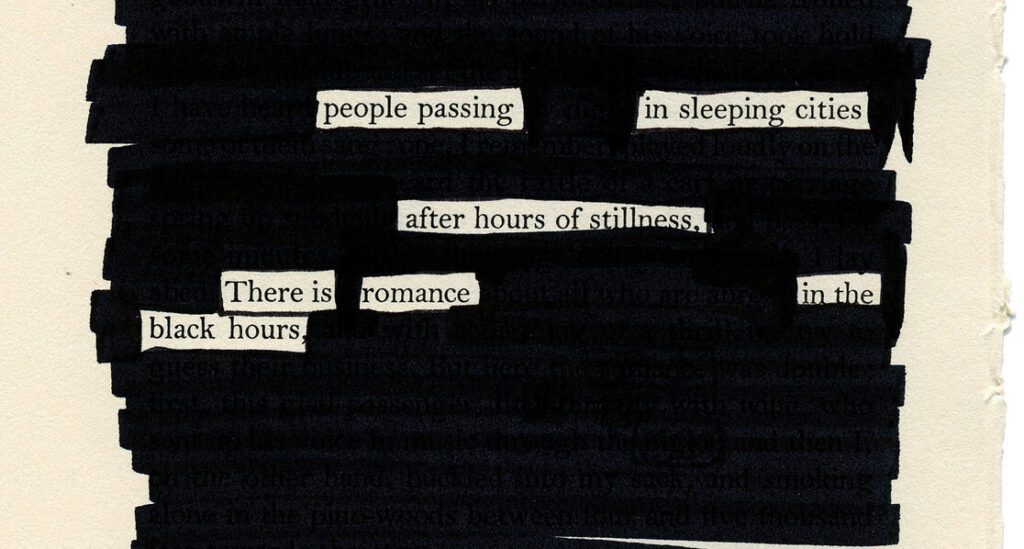Cover-up poetry, often blackout poetry, is a captivating and creative art form. It involves transforming existing texts into new poetic expressions by selecting specific words and phrases. Poets can choose from various sources, such as newspapers, magazines, or books, crafting unique narratives from the original content. This innovative approach encourages creativity and redefines how we perceive and interact with language. Lately, many exciting new poets are emerging in this vibrant genre.
Let’s explore the intricacies of Cover Up Poetry, including its themes and techniques, while spotlighting some talented voices shaping its future.
What is Cover Up Poetry?
Cover Up Poetry is all about manipulation and imagination. The process begins with a printed page, often featuring a large text block. Poets then select words or phrases to create a new piece of poetry, leaving the rest obscured or blacked out. This technique allows for fresh interpretations of the original text, turning mundane phrases into profound reflections.
Example:
Imagine a page from a newspaper article about a city’s struggles. A poet might highlight phrases like “hope,” “resilience,” and “community” while blacking out the rest, creating a poem that reads:
“Hope rises,
in the heart of the community,
resilience shines bright.”
The Visual Appeal
One of the most striking aspects of Cover Up Poetry is its visual component. The contrast between the obscured and highlighted text draws the reader’s eye, creating a dynamic interplay on the page. This visual appeal adds more meaning to the poem and engages the reader differently.
Poets often enhance their work with artistic designs. Some might incorporate colors, illustrations, or collage techniques. This visual artistry not only beautifies the poem but also adds emotional depth.
Example:
A poet could take a page of an old book and use black ink to blackout most of the text while leaving a few words visible. The poem might read:
“Find light,
in the shadows,
beyond the words.”
The visual representation emphasizes the message using bright colors around the highlighted words.
Accessibility and Community
Cover-up poetry is an accessible art form, welcoming anyone interested in poetry regardless of experience. The simplicity of the process encourages participation and creativity, making it an excellent way for beginners to dive into poetry without the pressure of traditional forms.
Social media has become a significant platform for sharing this art form. Instagram and TikTok are particularly popular, allowing poets to reach a wider audience. Hashtags like #BlackoutPoetry and #CoverUpPoetry help connect poets and fans worldwide, fostering a supportive community.
Example:
A poet might post a video on TikTok, showcasing their process of creating a blackout poem. They might start with a newspaper article and, fast-forward, black out the text while revealing their creative process. This not only entertains but also invites others to try it themselves.
Thematic Exploration
The themes explored in Cover Up Poetry can vary widely, reflecting personal experiences, societal issues, or abstract concepts. This diversity allows poets to express a rich tapestry of emotions and ideas.
Some poets use Cover Up Poetry as a platform for social justice. They create works that resonate with current events by repurposing texts that reflect cultural or political realities.
Example:
A poet might take an excerpt from a speech on civil rights and highlight phrases like “freedom,” “justice,” and “equality,” transforming the original context into a new poem:
“Freedom sings,
in every heart,
justice for all.”
This highlights the poet’s voice and emphasizes critical societal themes.
Emerging Poets to Watch in 2024
As we look ahead to 2024, several emerging poets are making waves in the Cover Up Poetry scene.
Here are a few notable figures to keep an eye on:
Social Media Sensations
Poets are increasingly gaining recognition through their vibrant online presence. Platforms like Instagram and TikTok allow them to showcase their Cover Up Poetry, often combining compelling visuals with powerful messages. One standout is Sarah Kay, who has utilized social media to share her poetic creations. Her work usually features snippets from various texts transformed into poignant, relatable pieces. Kay’s talent for connecting emotionally with her audience has helped her build a dedicated following.
Interdisciplinary Artists
Some poets are pushing the boundaries of Cover Up Poetry by blending it with other artistic forms, such as visual art, dance, and performance. Rupi Kaur is an excellent example of this trend. Known for her minimalist style, Kaur combines her poetry with illustrations, creating a cohesive artistic experience. Her performances often feature spoken word, where she reads her poetry while visual artists create live interpretations.
Diverse Voices
The new generation of poets showcases a rich tapestry of backgrounds and experiences, bringing fresh themes and perspectives to Cover Up Poetry. Ocean Vuong, a poet of Vietnamese descent, exemplifies this diversity. His work often explores themes of identity, trauma, and love, and he frequently incorporates elements from his heritage.
Activists
Many emerging poets use Cover Up Poetry as a platform for social activism, addressing critical issues like climate change, racial injustice, and mental health. Amanda Gorman, who gained national recognition for her poem at President Biden’s inauguration, is an inspiring figure in this movement. Her poetry often tackles systemic issues and inspires change, resonating with audiences worldwide.
Conclusion
Cover Up Poetry is a unique and powerful way to engage with language and art. This art form continues to evolve, welcoming new voices and perspectives. The combination of creativity, visual appeal, and community makes Cover Up Poetry an exciting space for exploration.
Whether you are a seasoned poet or just starting out, this genre invites everyone to participate. The emergence of new poets promises to expand the boundaries of Cover-up Poetry, creating works that resonate with contemporary audiences. Embrace this dynamic art form and discover the beauty of hidden words waiting to be uncovered.
For poetry and more, visit Mecella.

